This chapter looks at some of the ways you can measure the performance of your SEO efforts. It’s good to do, whether you are working on your own site, to justify the time and effort spent, as well as to measure the ROI if you are paying someone, or if they are paying you!
Ultimately the ideal spot to reach is the first page of search results for a given keyword, and the top spot. Often SEO “rank” programs will only measure “down” to the 100th search result. At the beginning, if you’re a new or small web site, it may be some time before you can crack the top 100 search results for a keyword, but it is still worth trying, and regardless of the exact rank, it’s absolutely true that adding relevant, quality content to your site will make it stronger no matter what, regardless of the rank on Google, for the people who do visit it.
There are different philosophies about what kind of effort to put into SEO versus SEM, and there’s no one correct answer for everyone. SEO is likely to be an important skill and a good source of income for quite some time, and it stands to reason that if you focus your SEO efforts around developing quality content, it’s unquestionably a good investment, even if you don’t get the exact rank you want. It’s worth saying that there are those who recommend making sure your SEM efforts are off and running first, where you can jump to the top of page 1 with the right bid, for example. But even SEM efforts are affected by quality content—when you deploy content for SEO, it can also boost SEM efforts, through a metric called your quality score. (See my book, Introduction to Search Engine Marketing and AdWords, for more information.
But in the end, is SEO worth it? Absolutely. Make sure to learn how to measure the performance.
Fun with SEO: Check Your SEO Rank!
One way to measure and monitor the performance of SEO efforts is to look at the rank of your web site for particular keywords. There are a number of tools available—some free, some free trial and then pay, and so on. Here’s one to try:
SEO Centro: http://www.seocentro.com/tools/search-engines/keyword-position.html or http://tinyurl.com/seocentrokp .
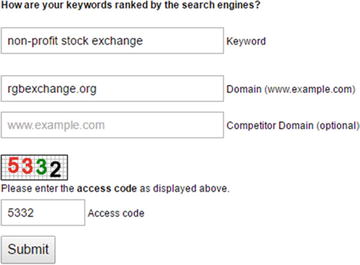
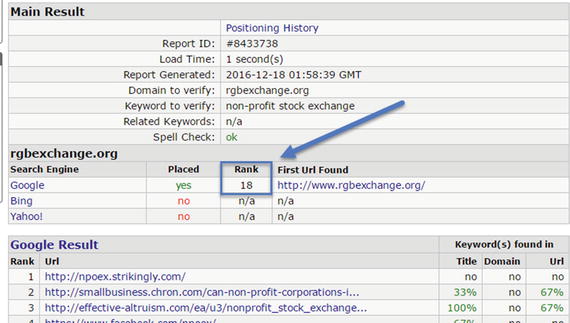
Maintain the rank: There is competition for online keywords, and it will continue to increase as the Internet grows and the world becomes smaller. Maintaining existing rank is a good goal.
Increase the rank: This might involve a strategy of doing some of the technical tweaks to make sure all the appropriate basics are done, and then work on developing and expanding keyword targets, in partnership with any search engine marketing efforts. You try to increase the rank through consistent deployment of quality content, over time. Not just content, mind you, but quality content, based on finding out and even testing what your customers actually are interested in.
Here is an article with some relatively recent free/free-trial SEO checkers, which is worth checking out. It’s called Shout Me Loud: https://www.shoutmeloud.com/5-excellent-websites-to-check-keyword-ranking-in-google.html or http://tinyurl.com/sml-seo .
Among other tools it talks about SEM Rush, which is a pretty standard SEO tool that ties into SEM. There is a free 14-day trial and it’s probably a good investment. Compare the free trial/paid tools to any “entirely free” tool, and you will get what you pay for.
Fun with SEO: Hunt for Duplicate Content!
Duplicate content is a large no no. You never want to have multiple pages on your site with exactly the same content, unless it’s unavoidable (as it might be on some larger e-commerce sites). The strength of content is in its uniqueness. It is an important thing to watch for, as is fairly common (pages copied, forgotten, material paraphrased, pages migrated from one place to another, redundancy—you name it! It happens). It’s common enough to be a part of a good SEO audit.
Hunting for duplicate content can be fun and rewarding and it’s also “low hanging fruit” as part of an SEO audit. It also gives you more time to increase your SEO rank.


It will look for duplicate content on your site and give you a way to look back and see if it is redundant or necessary. The reason duplicate content is a big deal is because Google can punish you for having it if it thinks you’re using it as a way to get higher rankings nefariously. Also, good content is worth it, in it’s own right.
Reporting can include potential redundant content and part of the SEO process would be taking content away. Wacky, right? Here you are wanting to add content and there you are taking it away. But not all content is created equal, especially if it is duplicated or “cloned,” as it were.
Some people like clones I, suppose. But not Google, at least when it comes to content clones .
Other Analysis: Analytics
Okay, in the end, “rank” is one of the main things to monitor, but not the only one. You saw how an SEO audit can reveal duplicate content; that’s another thing to monitor, periodically even, especially if you are at a larger company. Eventually, sooner or later, you will want to get into analytics.

But what happened to that bus? Well, we didn’t have a hit radio single, and I landed in a cubicle at an Internet startup company, like a fish out of water. If you’d asked me whether I had an interest in analytics, or Excel, or numbers of any kind, or even marketing, I would have laughed out loud. (What, me? I’m a creative person.) But being a creative person doesn’t always pay the bills. I continue to at least try to be creative, and that’s one of the reasons I like inserting silly pictures into the books I write.
Over time, as I experienced the phenomena known as being laid off, I realized that there are parts of companies and things they do that make money, and then there are things that cost money. Marketing, if it’s done well, is one of those things that helps make money, and I gravitated toward it. I also realized that even creative people can gradually get more comfy with things like Excel, and numbers, and analytics. In other words, learning numbers and analytics is a good idea even if you’re not an accountant.

(Image designed by Freepik.com.)
Help a business not waste money
Help a business decide what to invest in
Help a business make money
Keep your job
Keep a client happy
Expand your career
Have interesting things to say in meetings
Sound like you know what you are talking about
Know what you are talking about
And many more.
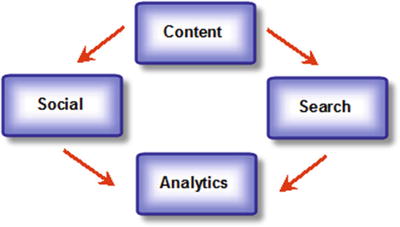
It’s worth taking time to learn these things outside of SEO. There are many free resources out there, including a Google Analytics Certification and free study material from Google. (And there’s my Introduction to Google Analytics book too).
For SEO, it’s good to note that Google Analytics can provide a foundation for giving insights about some parts of SEO. When it is set up correctly and connected to Webmaster Tools (now called Search Console), it can provide you with fairly detailed information right from your own site that can monitor the way individual keywords perform.

The original Holy Grail was a cup made out of Gold. But the next best thing to the original grail is to be able to measure how much gold you get back, when you invest your gold. Another name for tracking your gold is conversion tracking.
Fun with Conversion Tracking in SEO
Get you a job
Help you keep your job
Help other people keep their jobs
Help everyone get a bonus
Help people get a holiday bonus
Make all your dreams come true
Conversion tracking essentially allows you to answer a manager or client when they say, “Okay, so we spent a lot of money. How much money did we make?”

King Arthur: “Okay, how did we do with radio advertising this week?”
Lancelot: “Well, we had a lot of impressions.”
King Arthur: “Okay, but how many people purchased our knightly protection service based on radio ads?”
Lancelot: “Um . . . . . . .”
King Arthur: “Okay, how did we do with pay per click advertising on Ye Google?”
Gawain: “King Arthur , because of our goodly conversion tracking, we were able to ascertain that two townsfolk of good repute did indeed buy our knightly protection services.”
King Arthur: “And how much did we pay Ye Google?”
Gawain: “King Arthur, we did pay Ye Google a fee of 10 gold pieces for the magic clicks on our advertisements in the town, and we generated 100 gold pieces in return.”
King Arthur: “I like this conversion tracking. Why aren’t all the knights of the realm doing this?”
Lancelot, grumpily: “King Arthur, it takes effort. I’d rather be off riding and rescuing than doing configuration on conversion tracking.”
King Arthur: “Ah well, the royal treasury is not what it used to be, what with Saxon rampages and other unexpected events. Going forward, all knights shall use conversion tracking.”
Knights: ::groaning and grumbling::
King Arthur: “Yes yes, but I’ve decided that it will be our new Holy Grail!”
Knights: ::applause::
So the moral of the story is that conversion tracking is important.
All this to say that it does require some effort, whether with SEM or SEO. We’re not going to dive into that in this introductory book, but it’s important enough to mention, emphasize, and consider.
With SEM, in a nutshell, you can set up conversion tracking, and if you’re selling something it typically means putting a piece of code on an order confirmation, and it beams a little signal to Google saying that a sale has been made. When all the pieces are put together, you can actually track how much revenue is generated from an individual advertisement or keyword. This is a tremendous thing, and it’s one of the reasons Google is one of the most profitable companies on the planet—because they figured out how to do trackable advertising.
measure how much money is made by organic keywords
Yeah, sorry, that’s quite a mouthful. But it’s a good thing to chew on.
People searching for something on Google with a specific keyword
People seeing your organic search result (as a result of your SEO effort)
People buying a product based on that keyword
To repeat, you will be able to see how much money resulted from SEO efforts. Exactly. It’s a really good, strong thing to do. Not only can it help win more attention, more serious attention, or attention at all from a client, manager, etc.—but it also results in more investment. It results in more scrutiny, but it gives you a strong leg to stand on.
In other words, when clients or managers don’t really understand SEO, and do it on faith because someone said they should, or because they read an article about it, they may be willing to invest in it, but still don’t take it seriously. If the budget is reduced for any reason, and the heat is on, then that line item expense (or job) could be on the line. How much better, then, to flip the tables, measure things out, and work toward proactively gaining scrutiny, by demonstrating how organic SEO can actually make money.
It’s also a very real possibility that consistent, longstanding efforts at SEO could generate revenue and profit. Even if it doesn’t start out that way, even if it is a long-term investment to increase rank or customer appreciation of the quality content on a site—even if it’s a while before you can actually prove a sale is coming through organic keywords—it is absolutely worth exploring.
Conversion tracking can make that happen. Google “conversion tracking adwords” or “conversion tracking of SEO in Google Analytics” and things like that. It requires some hoops, it’s outside of the scope of this book, but I’ve had my say, and I’ll leave it at that.

A recruiter or potential employer or potential client might actually notice.
Set Up Google Analytics: Blogger, Google Sites
So let us return to simpler things in this introductory book. Google Analytics is very easy to set up in Blogger and Google Sites, so I invite you to do so, in order to get more familiar with it. We’ll look at one of the basic SEO-related reports you can run without having to set up conversion tracking.
Setting Up a Google Analytics Account
- 1.Go to http://google.com/analytics and sign in and/or set up an account.

If it’s the first time you’re using it, Google may guide you through a wizard to set up a web site. Enter your blog address for the web site, such as http://toddsmarketingblog.blogspot.com .
- 2.There’s more than one way to add a web site to Google Analytics. If you’ve used it before, you can access the Admin menu:
 Then select the Account drop-down menu:
Then select the Account drop-down menu: And click Create New Account:
And click Create New Account:
- 3.Next, you enter your web site information.
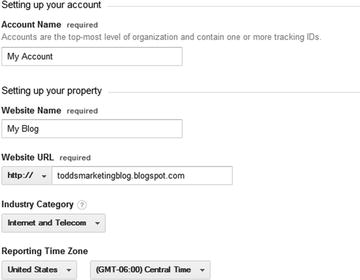
- 4.Give your site a name, enter the address/URL, choose a category, and set the time zone. At the bottom, click Get Tracking ID:
 Note The Tracking ID is the piece of information that you put on your web site, in order to connect it to Google.
Note The Tracking ID is the piece of information that you put on your web site, in order to connect it to Google.
- 5.
Copy the tracking ID into memory. It will look something like UA-61356709-1. (It will be a specific, unique code for your site/blog.)
- 6.Next, log in to your Blogger blog and go to Settings:
 Then select Other:
Then select Other: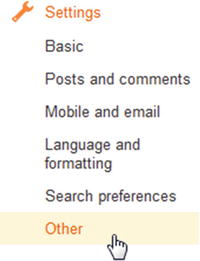
- 7.Enter your Google Analytics ID (Note: it will be a specific number you got from your own account, not the one shown in this image).

- 8.Click Save Settings.

Now you’re all connected! Potentially immediately, or certainly after a few days, you’ll be able to go into Google Analytics and look at detailed information about your site.
Create a New Property for Each New Web Site
Note
You can have more than one Google Analytics account, such as one for each web site, but generally people use one Google Analytics account and include all their web sites in that account.

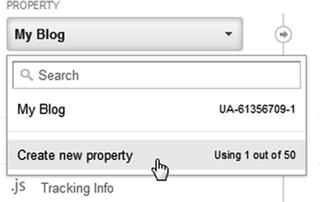
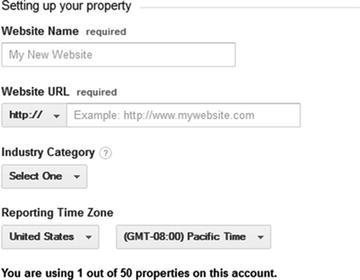
Note
For each new site/blog you want to track, you need a tracking ID—that’s the piece of information that you use to connect your web site to Google Analytics.
Google Sites: Enter the Google Analytics Tracking ID
Note
This step assumes that you’ve created a new property in your Google Analytics account, and that you have a new tracking ID. You need a separate, unique tracking ID for each site/blog. You can’t use the same one in multiple sites/blogs.
At the time of this writing Google is transitioning from Classic Sites to New Sites. At the moment only the Classic Sites allows you to connect to Google Analytics. By the time you read this the New Sites might allow it too. Just give it a shot, and if it doesn’t work, try getting in touch with your Inner digital analytics detective, and try doing the equivalent in a free Weebly site. You make a free Weebly site and then research how to connect it to Google Analytics.
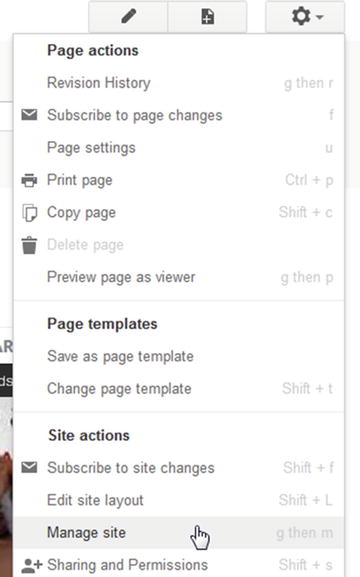
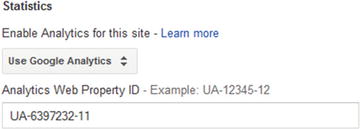

Now you’re all connected! Potentially immediately, or certainly after a few days, you’ll be able to go into Google Analytics and look at detailed information about your site.
Fun with Analytics: Using Your Superpowers
- 1.
First, log in to Google Analytics.
- 2.Check the Date Range to be aware of what time frame you are looking at it, and change it if desired:

- 3.Click on All Web Site Data:
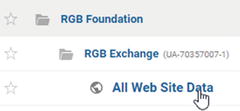
- 4.In order to find the right report, look for the search box:

- 5.Try typing in All Traffic Channels and select it from the pop-up menu:
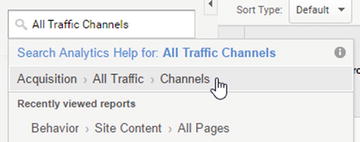
You will get more out of it the longer you have Google Analytics installed, and the longer you’ve been promoting your site (so that not only are people visiting it based on your initial promotion, but ideally searching for it on Google). If you want to see what it’s like, but don’t have a web site, e-mail me at [email protected] and I will invite you to the RGB Foundations Google Analytics account so you can take a look around. (No promises mind you, but it’s an option.)
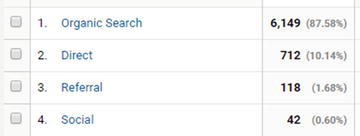
Another thing to consider with SEO is to set the goal of increasing traffic from organic search over time, based on the amount and the proportion of traffic. In some ways, SEO is like an investment that becomes a source of ongoing income—you do have to maintain it, but when the right things are done and everything falls into place, it is possible to generate traffic, sales, etc., without having to spend money. Managers and clients will like this. (Technically, you are spending money by having someone work on SEO, but it at least sounds good. And there’s some legitimacy to it.)
Analysis techniques for Google organic search and SEO: https://support.google.com/analytics/answer/3306157?hl=en or http://tinyurl.com/seo-googa
You might find reading a book helpful, such as my book, Introduction to Google Analytics (Apress, 2017).
Conclusion
Congratulations on launching into the deep world of measuring performance with SEO. It can be a journey, and you might have to do a bit of exploration, especially for the Holy Grail (conversion tracking).


From one superhero to another, best wishes with your new found superpowers!
(If you want to procrastinate before you read the next chapter, feel free to check out these pics of my past life in rock ‘n’ roll. See http://tinyurl.com/tkrocknroll .)
Of course, feel free to reach out to me on LinkedIn: http://linkedin.com/in/tekelsey .
